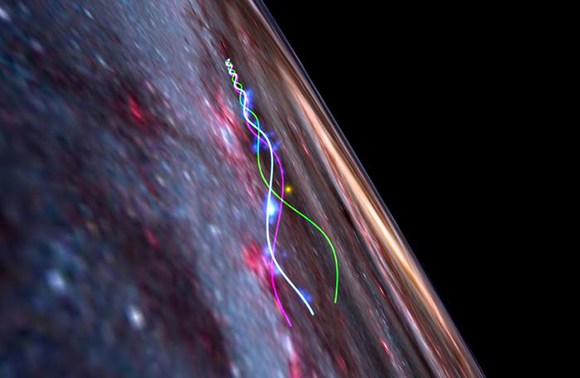It is commonly recounted that after his conviction in court, Galileo Galilei uttered the phrase attributed to him, "And yet it moves." Historically, this referred to Earth orbiting the sun; metaphorically, the phrase could also apply to much larger astronomical bodies, such as the entire solar system or entire galaxies. Indeed, everything known to us is in motion, dynamically interacting everywhere, simultaneously, and all the time.
Yet, there are colossal structures that move so slowly that, relatively speaking—compared to Earth's motion around the sun, for example—one might argue that they do not move at all. One such structure is the "Radcliffe Wave" - a superstructure that spans about 9,000 light-years (~85 quadrillion meters) and is primarily composed of gasses. Given that new stars are born from accumulations of galactic gas clouds, the "Radcliffe Wave" can also be described as an extraordinarily fertile birthplace for stars.
It is extremely difficult to measure the velocity of such a massive entity, yet this difficulty does not deter astrophysicists and cosmologists in their pursuit of new discoveries. The development of advanced new-generation space telescopes, such as the James Webb Telescope launched into space about two years ago, allows researchers to dream big.
Operating alongside the James Webb is the Gaia telescope, launched by the European Space Agency about a decade ago. Thanks to recent observations from Gaia, it has been confirmed that the Radcliffe Wave is aptly named—the structure is indeed oscillating
The Radcliffe Wave is indeed oscillating. Illustration of the structure's movement against the backdrop of our sun (the yellow dot). The blue dots represent clusters of young stars | Ralf Konietzka, Alyssa Goodman, and WorldWide Telescope
A Wave Worthy of Its Name
Discovered merely four years ago, the Radcliffe Wave is a colossal structure found about 500 light-years (~4.7 quadrillion meters), from our Sun at its nearest point, stretching across one of our galaxy’s spiral arms. Named after the Radcliffe Institute for Advanced Study at Harvard University, where many of the researchers involved in the structure's discovery in 2020 were based, the discovery was initially surprising, primarily due to the structure's relative proximity to us.
Now, another revelation emerges: a recently published article in the prestigious Nature journal, cryptically titled "The Radcliffe Wave is oscillating," co-authored by some of the original discoverers. It seems only logical that this structure is in motion, as it forms part of a galaxy that rotates around itself.
What is less trivial is the periodic oscillation of the structure, only now identified. It turns out that the moniker "Wave" was a well-informed guess, as the nature of the structure's movement was not known at the time of its initial discovery.
The researchers gained new insights by measuring the velocities of carbon monoxide gas and clusters of "young" gas within the wave. They observed that the movement of the gaseous material resembles that of a progressing wave, akin to ocean waves. This periodic motion exhibits a defined direction of progress, influenced by the gravitational acceleration exerted by the galaxy.
This understanding enables researchers to view the Radcliffe Wave as an independent structure, allowing them to assess its local properties. Additionally, they can glean insights into the frequency of vertical oscillations of our Sun, as the entire structure extends beyond the plane of the galaxy and is located outside it.
1 View gallery


The movement of the gaseous material resembles that of a progressing wave, akin to ocean waves. Illustration of the wave's motion: The white line illustrates its current shape and trajectory, while the green and purple lines predict its future movement
(Ralf Konietzka, Alyssa Goodman, and WorldWide Telescope)
However, much remains unknown, and many questions linger – for example, why was the Radcliffe Wave formed? Why does it move as it does? Was its formation a random event or is it characteristic of all galaxies? And how many such superstructures exist out there, concealed from our eyes?
Among other hypotheses, researchers speculate that the formation of the Radcliffe Wave is related to intergalactic interactions. Given the understanding that the Milky Way formed from the merger of several ancient galaxies, which is an ongoing process.
This tendency of galaxies to attract and even collide with each other has led some researchers to speculate that our galaxy is presently engaged in a slow collision with a neighboring galaxy, affecting its structure. Is there a correlation between this collision and the Radcliffe Wave? At present, the answer remains elusive, but the question is actively engaging several dedicated researchers. Further investigations are expected to shed more light on this phenomenon.

